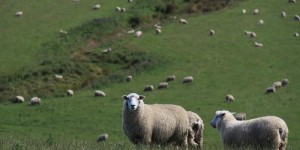 NEW Zealand recorded its highest ever average spring lambing percentage in a smaller prime lamb breeding flock in 2017, but more ewe hoggets were joined last year.
NEW Zealand recorded its highest ever average spring lambing percentage in a smaller prime lamb breeding flock in 2017, but more ewe hoggets were joined last year.
Based on the latest data from Statistics NZ and Beef + Lamb NZ’s 2017 Lamb Crop report, Meat & Livestock Australia said New Zealand’s lambing percentage for spring 2017 increased by 1.9 percent year-on-year, to 127.3pc.
This is the highest annual average lambing percentage recorded for NZ, up from spring 2016 which previously held the record at 126.2pc. Good climatic conditions and ewe condition at mating and lambing were contributing factors.
MLA said New Zealand’s lamb crop in spring 2017 was estimated at 23.7 million head – down 1.1pc, or 260,300 head, from 2016.
Breeding ewe numbers, as at July 1 2017, eased 2.4pc year-on-year, to 17.7 million head. The decline was largely in response to culling older ewes to take advantage of strong mutton prices, as well as some producers transitioning out of sheep to other land use options. However, the number of ewe hoggets put to rams increased 15pc from 2016, to just over 1.95 million head.
The NZ data said early season schedule prices reflected strong market demand for lamb in NZ – largely driven by a lack of slaughter ready lambs. Reduced availability at the beginning of the season was attributed to the lower growth rates reported across much of the country, which saw producers holding onto stock for longer to finish them.
MLA said the total number of lambs processed during the first quarter of the NZ season (October – December) was expected to reach 4.42 million head, up 2pc from the same period last year.
This first quarter is estimated to make up 23pc of NZ lamb processing for the 2017-18 season. The forecast total for 2017-18 (October – September) is 19.27 million head – up just marginally from the previous year, as producers retain replacement lambs to maintain flock numbers.
Australia and NZ are the world’s largest exporters of sheepmeat, accounting for about 71pc of global exports in 2016-17 (OECD-FAO). Reduced supplies in both countries supported lamb and mutton prices over the last year.
MLA said although NZ lamb slaughter is expected to increase slightly, lamb exports in 2017-18 are forecast to remain fairly flat, due to lighter carcase weights.
Australia is competitively-positioned for export growth, with NZ exports anticipated to remain relatively constrained, MLA said. In fact, a likely modest year-on-year increase in 2017 will see Australian lamb shipments reach a new high for the calendar year.
Sources: MLA, Statistics NZ, Beef+Lamb NZ.

HAVE YOUR SAY